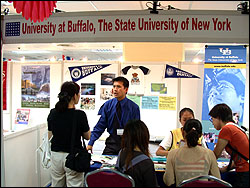Recruiting efforts pay off
Number of international students attending UB increases
By
SUE WUETCHER
Reporter Editor
It
sounds like the perfect job—visiting exotic countries and meeting
all sorts of interesting people from many cultures.
| |
 |
| |
Joseph
Hindrawan (with tie) speaks with a prospective student during a
recent college fair held in Taiwan. Participation in these overseas
fairs and visits to local schools has helped the Office of International
Enrollment Management significantly increase the number of international
students attending UB. |
| |
|
But,
as Joseph J. Hindrawan, assistant vice provost and director of international
enrollment management, can attest, traveling the international student-recruiting
circuit is anything but glamorous.
But
the efforts of Hindrawan; Steven L. Shaw, director of international
admissions, and the rest of their staff have paid off. The number of
international students attending UB has been increasing steadily during
the past five years, from 6.81 percent of the total university enrollment
in Fall 1996 to 11.07 percent of the total enrollment in Fall 2001.
And the work will continue—Hindrawan says his office has been given
a target of 13 percent of the total university enrollment by Fall 2006.
That figure would bring UB in line with many of its peer institutions
of similar size and ranking, he adds.
While
recruiting trips overseas can be grueling—UB staff members routinely
take part in fast-paced, organized tours in which they spend only a
day or two in a number of countries—they can have an immediate
impact, Shaw says, noting that after Hindrawan's first such trip to
Asia in 1995, UB saw an increase in graduate enrollment during the next
admissions cycle.
"It's
a matter of getting our name and information out there," he says, likening
these trips to the university or college fairs that are held in hotels
in the U.S. "We have the programs, we have the quality, we have the
affordable costs that many of the internationals are looking for."
Compared
to other U.S. institutions, UB always has had "fairly good name recognition"
and some "fairly high-placed graduates" in such countries as Taiwan,
Korea and Japan, Shaw says, adding that "alumni can be key" to recruiting,
arranging meetings with students and parents.
While
on these fall recruiting trips, UB staff members also visit local high
schools and international schools, as well as the counsel sections of
the U.S. embassies, Hindrawan says. These side trips provide a wealth
of information about such things as visa requirements and education
trends in the country—like which majors students are most interested
in—he says. Shaw adds that information pertaining to graduate students
is shared with the various schools and departments at UB that handle
graduate admissions.
Hindrawan
notes that UB staff also makes overseas trips in the spring to follow
up with students who expressed an interest in UB during the fall recruiting
visit. These visits are focused on trying to "convince students to come
here, trying to get the yield as high as possible," he says.
Since
that first recruiting trip in 1995, Hindrawan and his staff have significantly
stepped up the overseas outreach effort. Besides Asia, staff members
visit fairs and schools in the Middle East and Latin and Central America.
The itinerary for this spring included stops in Thailand, Philippines,
Singapore, Malaysia, Indonesia, Japan, Taiwan, Korea, Mexico, United
Arab Emirates, Kuwait, Oman and Bahrain.
Moreover,
this year Canada—especially Southern Ontario—has been a focus
of efforts.
Hindrawan
notes that secondary education in Ontario is moving from a 13-year system
to a 12-year system. That means there will be two batches of high school
graduates next year—too many students to be accommodated by Canadian
universities, he adds.
While
UB's affordability may take a big hit with the current U.S.-Canadian
exchange rate, the university's proximity to Canada and the availability
and quality of programs should be selling points to attract Canadian
students, Hindrawan and Shaw say.
In
fact, the Office of International Admissions—part of International
Enrollment Management—has developed a new Web site http://wings.buffalo.edu/intadmit/canadian/index.html
specifically for prospective Canadian students.
Shaw
and Hindrawan say that contrary to the popular wisdom, the events of
Sept. 11 have not affected UB's international student-recruiting efforts.
Staff
attended educational fairs in Asia at the end of September, and for
the most part, only Japanese students and parents expressed concerns
about security, Hindrawan says.
Most
Asian students have not let Sept. 11 change their plans to come to U.S.,
Shaw points out.
"Can
you imagine an American parent sending their 17- or 18-year-old child
clear across the world where the parent doesn't speak the language and
a catastrophic event happens there?" he asks. "(Asian) Parents are much
more realistic and knowledgeable in a world view. Maybe they won't put
their kid right in New York City, but they know they have to have an
education, they want a good education. This is a relatively safe place.
And they'll do it."

